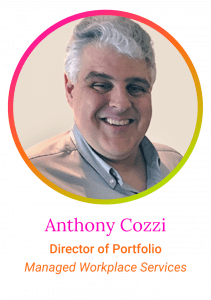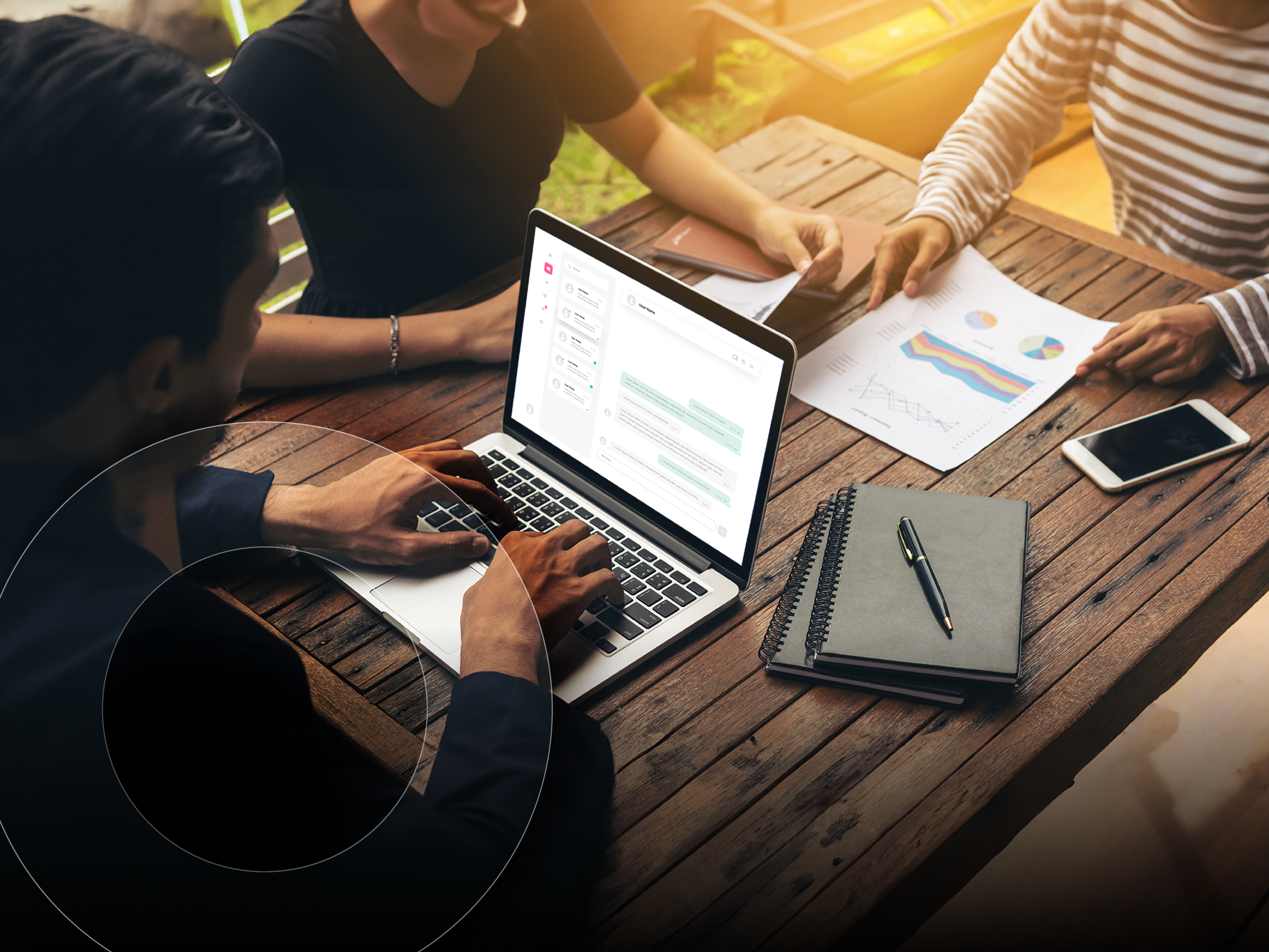How smart IT management helps you create a long-term EUC strategy:
Don’t let hybrid work’s most tedious IT tasks become daily time-drainers.

“How do you get out of the reactive mode of constantly chasing problem after problem? Look at it from the macro level.” – Anthony Cozzi, SHI’s Director of Portfolio – Managed Workplace Services
What does a smooth day look like for your business? Is it hosting virtual client meetings without embarrassing technical issues, or creating quotes, reports, and mockups without applications or devices crashing? Maybe it’s retrieving trusted client data and scheduling proactive appointments or performing offsite inspections without losing access to your cloud-hosted tools.
No matter how you qualify it, one thing’s for sure: when it’s a smooth day at work, you probably don’t even think about it. That’s why IT teams are often the unsung heroes of your workplace – because an easy day for sales, finance, or marketing is often the result of a day of firefighting, bug-squashing, and device management for IT.
But with the intricacies of managing a hybrid workplace and the shifting business priorities of an uncertain global economy, daily firefighting can easily become time-intensive tail-chasing. This prevents you and your IT teams from focusing on the future and developing long-term end-user computing (EUC) strategies that could make lasting impacts on your business.
How can you stop the endless tail-chasing and start futureproofing your EUC management? We’ve consulted three of SHI’s in-house modern workplace experts to help you take your best first steps.
Tired of chasing your tail? Automation and DEX can help
 When common issues turn into routine tedium, they draw IT’s attention away from more critical tasks, constraining resources that could otherwise address larger threats. That’s why Dave Gruver, SHI’s Field CTO, suggests automating high-volume tasks – so you can remove unwanted complexity and refocus on what matters most.
When common issues turn into routine tedium, they draw IT’s attention away from more critical tasks, constraining resources that could otherwise address larger threats. That’s why Dave Gruver, SHI’s Field CTO, suggests automating high-volume tasks – so you can remove unwanted complexity and refocus on what matters most.
“Start by automating repeatable tasks like password resets, admin rights requests, and software updates,” Dave says.
With almost 30 years’ experience working in enterprise IT, Dave knows how important consolidation can be for maintaining a healthy, sustainable IT workload. “From there, you can review your endpoint software stack for rationalization opportunities. Pay close attention to your security tools and consider where you have overlap or limited value.”

Kevin English, SHI’s Senior Director of Strategy and Product Management for Managed Workplace Services, agrees. For Kevin, knowing what to automate goes hand-in-hand with knowing your organization’s IT maturity.
“A lot of customers are still automating their provisioning process. They’re using traditional tools like SCCM or are just now starting to use Autopilot and Apple Business Manager,” Kevin says. “But if you’ve achieved over-the-air provisioning (OTAP) and can reduce the time it takes to image a laptop from, say, 4 hours to 15 minutes, then you can move on to your digital employee experience (DEX) as a means of improving your maturity.”
Kevin’s mentioning of DEX brings a smile to Anthony Cozzi’s face. Anthony, SHI’s Director of Portfolio for Managed Workplace Services, is an expert proponent of DEX tools as a means of improving efficiencies while increasing employee satisfaction.
 “How do you get out of the reactive mode of constantly chasing problem after problem? Look at it from the macro level,” Anthony says. “That’s one of the many things a DEX tool can do. ‘How is this problem occurring?’ ‘Is it cyclical?’ ‘Is it affecting one user, or many?’ The more intelligence you gather, the more proactively you can solve a problem. A DEX tool gives you the visibility to do that.”
“How do you get out of the reactive mode of constantly chasing problem after problem? Look at it from the macro level,” Anthony says. “That’s one of the many things a DEX tool can do. ‘How is this problem occurring?’ ‘Is it cyclical?’ ‘Is it affecting one user, or many?’ The more intelligence you gather, the more proactively you can solve a problem. A DEX tool gives you the visibility to do that.”
Consolidate your service desk with multivendor platform support
Our modern workplace experts have seen it all too often – an organization has critical software from Company X hosted in a cloud environment provided by Company Y. When an issue occurs, and the organization contacts Company X’s support, they say it’s a Company Y problem. But when the organization contacts Company Y, they blame Company X.
“It’s an endless loop of escalations and finger-pointing,” Anthony says.
If automation seeks to offload menial tasks on the user side of IT, then SHI’s multivendor platform (MVP) support aims to enhance management on the vendor side. Through SHI MVP, organizations can consolidate support for multiple vendors, providing a single point of contact for contract renegotiations, issue escalations, technical support, engineering services, and more.
“With a service like MVP, you make one phone call, then a Level 3 technician from our team will investigate and solve the problem faster than most OEMs. And the best part? No bouncing back and forth. Our team handles any vendor blame games so you can get straight to issue resolution,” Anthony says.
“And between various OSs, smart phones, tablets, VR, and everything else, we’re seeing a substantial need for organizations to centralize their service desk under one provider,” Kevin says.
“That’s one of the many ways SHI MVP can help – we consolidate your points of contact while rapidly providing expert Level 3 support from the first call.” – Kevin English
During our discussion about MVP, Dave reclines a bit in his chair. It’s clear he’s reflecting on his own experiences and the substantial time that can be wasted going back and forth between multiple vendors.
“The benefit of MVP,” Dave says, “is that when a problem occurs, you can go to one trusted entity that has a deep understanding of your environment and expertise in your solutions. It allows you to solve multiple problems all in one place. Mean time to repair, frustration levels, IT burden – they all go way, way down while end-user satisfaction goes up.”
When should you consider consolidating your solutions?
Between automation and MVP, the path to smarter IT management is paved by removing tedium and addressing overlaps in your solution stack. But, as Dave tells us, rationalization isn’t about keeping as few solutions as possible. It’s about ensuring what you have is effective in solving your unique problems and use cases.
“Over time, applications build up like sediment. A new tool comes out, and you buy it without removing your old tool. After years and years, you finally stop to look at your solution stack and find a ton of layering and overlap. Trying to manage all this sediment is often what’s creating the problems you’re trying to solve.” – Dave Gruver
Dave’s point raises the question – to avoid solution ‘sediment,’ when should the consolidation process start? Dave responds with another analogy.
“It’s a treadmill; a cycle of new solutions is always releasing. When a solution piques your interest, ask yourself, ‘Does this solve my problem?’ ‘Does this displace a tool I already have?’ Make consolidation and rationalization a normal part of your governance lifecycle. You stand to cut costs, improve performance, and reduce complexity.”
“Sometimes, it’s not just about removing or replacing the solutions. It’s about the policies built within them,” Kevin says. “I see it all the time. Organizations set up policies 20 years ago and are afraid to rebuild them in the new software.”
“You’re right Kevin,” says Dave, “it’s not just the tools. I like to compare it to people with newer cars. Every new car has a backup camera, right? Well if you’re someone like me – let’s just say, older – your first instinct when you reverse is still to look through your rear windshield, even though the backup camera’s right there in front of you. You’re relying on an old capability just out of pure instinct or force of habit.”
SHI’s experts are here to help
Economic uncertainty, shifting business priorities, and the daily pressures of EUC management can make it feel like you’re always chasing your tail – leaving no time to build toward your future. But by taking a few steps today, you can set yourself up for smarter, less burdensome IT management tomorrow.
To improve your management methodology, modern workplace experts Dave Gruver, Kevin English, and Anthony Cozzi recommend:
- Automating common tasks such as password resets, admin rights requests, and software updates
- Improving your maturity with DEX tools
- Consolidating vendor support with MVP
- Rationalizing your solution stack as part of your governance lifecycle
Are you ready to build the best-possible EUC strategy for your organization? With unrivaled experience and insights backed by industry best practices, SHI’s experts are here to help solve what’s next for your modern workplace. Request a complimentary modern workplace consultation today to get started.




